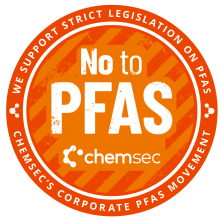PFAS are increasingly being recognised as a threat to our health and environment all across the world. And all across the world, the message from NGOs working in this area is the same – we need to stop using them. Swedish-based environmental NGO, ChemSec, has been working to promote sustainable chemical use for almost two decades, and here Dr. Jonatan Kleimark, Senior Chemicals and Business Advisor at ChemSec, presents the organisation’s newest initiative to fight these forever chemicals.
As people come together to tackle the coronavirus crisis, ChemSec has started a corporate movement that aims to take on another growing threat to our health and environment – PFAS. This chemical threat is even more ubiquitous than Covid-19 and has been found in every possible nook and cranny of the world, all the way from our own bloodstreams to some of the most remote regions of the planet. And like Covid-19, it needs collective global action to be solved.
This is why ChemSec has rallied progressive companies from around the globe to call for an end of the use of these forever chemicals.
Our initiative was announced in February, when award-winning actor Mark Ruffalo and director Todd Haynes were in Brussels speaking to the EU Parliament about the true story that inspired their latest Hollywood movie Dark Waters, in which an environmental attorney takes on chemical company DuPont and exposes decades of PFAS pollution.
The first two companies to join ChemSec’s Corporate PFAS Movement were fashion giant H&M and Danish retailer COOP. Soon after, more companies started to show an interest in joining the initiative. Just a week after the initiative had been announced, multinational home improvement company Kingfisher (which includes both B&Q and Screwfix) and the European Water Association EurEau signed the commitment. From then on, the ball kept rolling with more and more companies heeding the call.
At the moment, ten companies have joined ChemSec’s Corporate PFAS Movement, which entails:
- A call on policy makers to regulate PFAS efficiently, without the possibility for manufacturers to simply swap one PFAS chemical for an unregulated “cousin”.
- A call on the chemical industry to invest in innovation and develop safer alternatives to PFAS for all kinds of products.
- A recognition that PFAS are a major health and environmental problem.
- A commitment to end all non-essential PFAS uses in products and supply chains.
- A call on all other brands to join this movement and work towards a phase-out of PFAS in all kinds of consumer products.
PFAS is a chemical family consisting of almost 5,000 industrially produced chemicals favoured for their durability and well-functioning properties such as non-stick, water repellence and anti-grease. PFAS are used in a whole heap of different products, including cosmetics, food packaging, frying pans, outdoor gear and firefighting foam and have been used to such a degree that today 99% of humans, including foetuses, have measurable levels of PFAS in their bloodstreams.
What is worrying is that studies on humans have found links between PFAS exposure and a number of health disorders, including various cancers, lowered birth weights and negative effects on the immune system. Equally worrying is the fact that PFAS do not degrade. These chemicals are extremely persistent and can remain in nature for hundreds – or even thousands – of years, hence many people now call them forever chemicals.
Despite this, PFAS are, with very few exceptions, perfectly legal to use. This is why ChemSec now strongly urges businesses to join this corporate movement to end the use of PFAS in products and supply chains and help create the momentum needed for legislative action on the issue.
To find out more about ChemSec’s work on PFAS, or if you are a company interested in joining their initiative, follow the link to ChemSec’s own website below.


